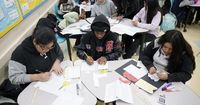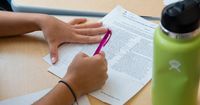On September 9, 2025, the release of the latest National Assessment of Educational Progress (NAEP) results sent shockwaves through the education community, policymakers, and families nationwide. The data, often referred to as the "Nation’s Report Card," painted a sobering portrait: American students are performing worse than ever in math, science, and reading, with historic lows recorded across several key grade levels. The implications, experts warn, stretch far beyond the classroom, threatening the country’s economic competitiveness and social cohesion.
The 2024 NAEP assessments, administered to eighth graders in science and twelfth graders in math and reading between January and March, were the first since the pandemic for these cohorts. According to The News Journal, the results showed no evidence of a nationwide rebound from pandemic-era disruptions. In fact, eighth-grade science scores in 2024 declined four points compared to 2019 and were eight points below 2015, with no significant improvement since 2009. High school seniors fared no better: their average reading and math scores were lower than ever before, with the average reading score down ten points compared to 1992, as highlighted by Education and Workforce Committee Chairman Tim Walberg in his official statement.
Chairman Walberg, responding to the data, didn’t mince words. “Today’s NAEP scores continue to show a devastating decline in math, science, and reading scores. Low academic skills don’t just hurt grades, they weaken our economy, workforce, and national security. Without strong foundations in these core subjects, America’s freedom and economic competitiveness will be in jeopardy,” he said. Walberg placed significant blame on what he described as “an unworkable one-size-fits-all regime” implemented by the Biden-Harris administration, as well as prolonged school closures driven by teachers unions and Democrats. He asserted, “Today’s NAEP scores are a tragic reminder of what happens when we fail to put students first. Now, Republicans and the Trump administration are prioritizing students—working to ensure every child gains the skills essential to be successful. This is crucial to America’s success.”
But the story is more complex than pandemic blame games. The Los Angeles Times reported that the slide in student performance is part of a decade-long decline that actually predates COVID-19. Twelfth graders’ scores in 2024 were the lowest in more than twenty years, and the drop in reading and math achievement was particularly pronounced for the lowest-performing students. In 2024, 32% of high school seniors scored below “basic” in reading—meaning they could not find details in a text to help them understand its meaning—while 45% scored below “basic” in math, the highest percentage since 2005. Only 33% of high school seniors were considered academically prepared for college-level math, down from 37% in 2019.
Matthew Soldner, acting commissioner of the National Center for Education Statistics, called the results a wake-up call. “Scores for our lowest-performing students are at historic lows. These results should galvanize all of us to take concerted and focused action to accelerate student learning,” he told Chalkbeat and the Los Angeles Times. The data also revealed that the achievement gap between the highest and lowest performing students in eighth-grade science is now the largest in the test’s history, further underscoring growing inequality in American education.
Experts point to a host of factors driving these trends. While the pandemic’s disruptions—remote learning, quarantines, and school closures—undoubtedly played a role, educators and researchers argue that the roots go deeper. The Los Angeles Times cited increased screen time, shortened attention spans, and changes in teaching methods as contributing to the decline. Carol Jago, associate director of the California Reading and Literature Project at UCLA, noted that high school students now read far fewer books than two decades ago, undermining their reading stamina and comprehension skills. “To be a good reader, you have to have the stamina to stay on the page, even when the going gets tough. You have to build those muscles, and we’re not building those muscles in kids,” she said.
Science education, too, is facing unique challenges. Chalkbeat reported that American eighth graders posted their lowest science scores since 2009, with average scores declining three to four points in physical sciences, life sciences, and earth and space sciences. The share of students scoring below the basic level in science rose to 38% in 2024, a five-point increase from 2019 and the highest since the current framework was adopted. Fewer students reported enjoying science class or feeling confident in their abilities, and those who did well on the test were more likely to have had hands-on, inquiry-based learning experiences—something that became rare during pandemic disruptions.
The gender gap in science, which had nearly closed before the pandemic, has now widened again as girls’ scores declined more steeply than boys’. Meanwhile, English learners offered a rare bright spot: their NAEP science scores increased by an average of six points in 2024, a surprising reversal from other standardized tests where this group was particularly hard hit by pandemic disruptions.
Education Secretary Linda McMahon weighed in, arguing that the scores “confirm a devastating trend” and show that federal spending has not improved results. She pointed to the Trump administration’s efforts to give states more control over education funding. However, critics noted that recent years have also seen cuts to science education funding and a reduced federal role in sharing best practices and improving teacher training, as Chalkbeat reported. The National Center for Education Statistics and the Institute of Education Science faced layoffs and contract cancellations, further complicating efforts to address the crisis.
Underlying all these developments is a shift in how core subjects are taught. The NAEP is not fully aligned with the Next Generation Science Standards, which are now used in more than forty states and emphasize inquiry and conceptual understanding over rote memorization. Yet, as Christine Royce of the National Science Teachers Association told Chalkbeat, engaging students in hands-on science requires time—a resource in short supply. Elementary students, for instance, receive just twenty minutes of science instruction a day on average, compared to sixty minutes for math and ninety for literacy. “Elementary school is where kids have questions, where they ask why. They really want to know,” Royce said, lamenting the missed opportunity to spark scientific curiosity early on.
Despite the bleak portrait, some educators remain hopeful that the crisis can catalyze meaningful change. As the nation grapples with these historic declines, the call for focused, evidence-based interventions—and a renewed commitment to student-centered learning—has never been clearer.


